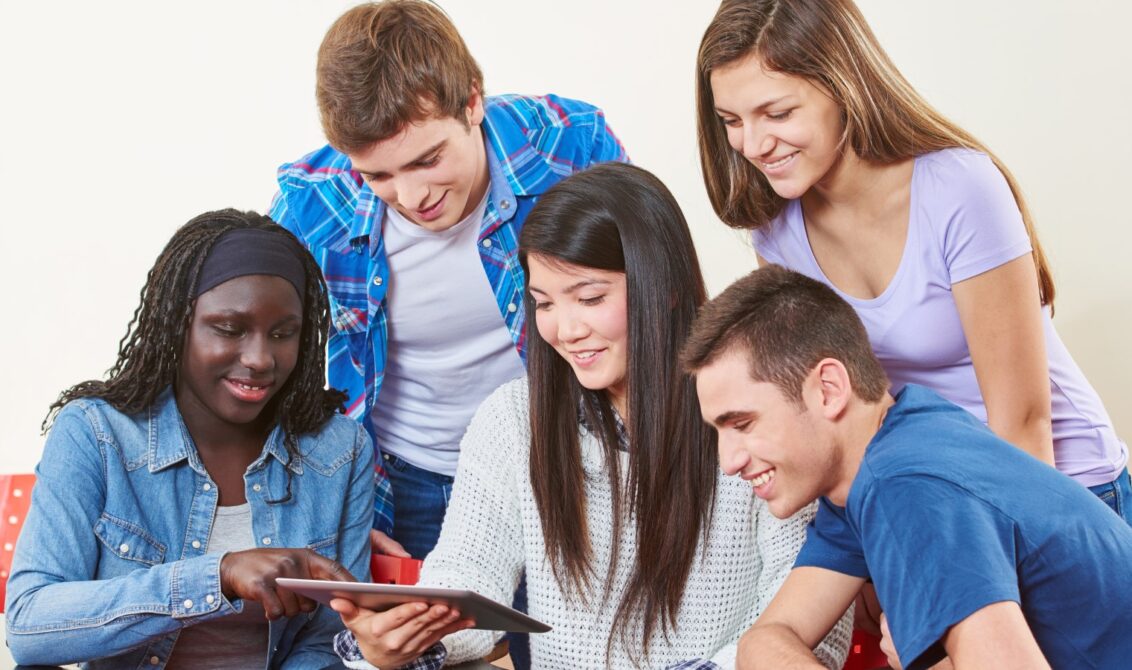
Collaborative learning is an approach which encourages students to work together in small groups. It has become more popular over recent years as a way of boosting student engagement and enhancing soft skills like critical thinking, communication and teamwork.
So, let’s take a deep dive into collaborative learning, the skills it promotes and how you can integrate collaborative learning into your classroom.
What is collaborative learning?
Collaborative learning is a way of shifting the focus from traditional, teacher-centred instruction. Instead, it’s all about group-based activities and cooperative interactions among students. This shift puts students front and centre as active participants in the learning process, making collaborative learning fun and engaging.
Through group discussions, problem solving, projects and peer feedback, students work together to share ideas, build new skills and achieve learning goals.
What skills are developed through collaborative learning?
With the increasing demand for skills-based education, collaborative learning is a great way for you to help your students develop the soft skills that employers and universities are looking for. Some of the skills your students will develop through collaborative learning activities are:
1. Critical thinking
Collaborative learning means working in groups, where your students will need to analyse information, assess different viewpoints and develop logical reasoning. Learners will be exposed to the different perspectives that come with working in a group, challenging them to think critically about various solutions.
2. Communication
Collaborative learning offers lots of opportunities to practise this essential life skill! Students will need to be able to express their ideas, practise active listening and engage in constructive discussions. As they build these skills, they will be more able to understand each other’s viewpoints and achieve common learning goals.
3. Problem solving
When it comes to complex problems or projects, collaborative learning is an interesting way for students to tackle them. Collaborating with their peers means that students get to practise their problem solving abilities as a group. They’ll have opportunities to pool their strengths, brainstorm ideas and collectively find creative solutions to whatever challenge they might be facing.
4. Time management
When working as a group, it can be easy for students to drift and lose focus. So, it’s important to give your students a timeframe to complete collaborative tasks. That way, they will need to learn to manage their time efficiently, both as individuals and as a group.
5. Interpersonal skills
Working collaboratively is a powerful way of enhancing your students’ interpersonal skills such as empathy, patience and conflict resolution. These skills will help them to build positive relationships both inside and outside the classroom. What’s more, prioritising these skills will help to foster a kind and respectful classroom culture.
6. Teamwork
As the teacher, you might be used to assigning leadership roles within groups, but resist the temptation! Instead, if you think your students require some structure, you can share the workload out by assigning roles such as notetaker, spokesperson, researcher, facilitator, etc. That way, students will still develop leadership skills, but they’ll also learn the value of working as an effective team member.
These skills will prepare your students for success in school, in university and in the job market. In the modern world, collaborative skills such as teamwork, interpersonal skills and communication are valued highly. So, if your students can gain a solid grounding in these skills, they’ll have a strong foundation for further academic, personal and professional growth.
Three activities for collaborative learning
Let’s take a look at some easy ways that you can incorporate collaborative learning in your classroom:
1. The Jigsaw Puzzle
Divide your students into small groups and provide each group with a different piece of information related to a specific topic or concept. Once they are familiar with the information, reorganise the groups and ask your students to share what they’ve learned with one another. After a couple of group swaps, your students should have a broad overview of the topic, gained through peer-to-peer learning.
2. Think-Pair-Share
This exercise is a good way to start off a lesson. Begin by sharing a prompt which is thought-provoking. Give students time to think about their responses individually. Then, pair them with a partner to discuss their ideas. Finally, encourage each pair to share their responses with the class.
3. Gallery Walk
The next time you’re introducing a new topic to your class, prepare posters or charts with different aspects of the topic and hang them around your classroom. Then, split your students into groups, and assign each group a different starting point. As your students move around the room, ask them to add their ideas or questions to each chart. This activity gets them up and moving, encouraging active engagement. As they move from chart to chart, they’ll explore multiple perspectives.
When planning collaborative activities, it’s important to keep your instructions clear and focused. Always require a product of each group’s work, even if it’s just a verbal summary of their discussion. That way, you’ll help them to stay focused. Finally, think about the way you organise the groups. Whether that’s random grouping, allowing students to self select their groups or deliberately placing students with different strengths together, it’s a good idea to mix it up each time.
The benefits of collaborative learning
This powerful approach equips students to become adaptable and communicative team players. It empowers them to learn from one another, helping them to develop valuable skills which will serve them well both in school and beyond. Teachers can inspire a passion for teaching and learning, cultivate a sense of community and engage their students in a new learning style. Collaborative learning is a good way to prepare students for a dynamic and interconnected world.
Subscribe to our blog
If you’d like to stay up to date with our latest articles, why not subscribe to our blog? You’ll get a fortnightly roundup of the articles you’ve missed straight to your inbox, plus links to free teaching resources.

